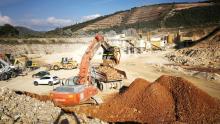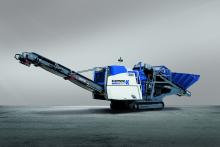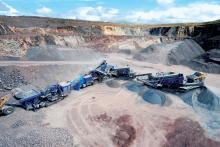
A Kleemann Mobicat MC 110 Z Evo jaw crusher is delivering great performance in an Italian gypsum quarry managed by Gyproc Saint-Gobain. Lucio Garofalo reports.
Italy is one of the major producers in Europe of gypsum, a material found in abundance in Piedmont (near Asti), Sicily and the Marches, as well as in Emilia-Romagna. In this latter region, gypsum is found in the province of Bologna, but its occurrence is more pronounced in the Vena del Gesso Romagnola, where a gypsum ridge with an average width of 1.5km runs for about 25km.
The occurrence of gypsum is traced to the cyclic lowering of the sea level of the Mediterranean during the Messinian age (Miocene epoch), caused by the closing of the Strait of Gibraltar. Without exchange with the open ocean, the sea dried out, aided by a high rate of evaporation and hypersalinity. Over tens of thousands of years, pockets formed where enormous quantities of salts were deposited, especially calcium sulphate (gypsum) and chlorides. The phenomenon, also known as the Messinian Salinity Crisis, had a cyclic pattern (repeated filling and evaporation), which explains why the Vena del Gesso Romagnola is formed out of 15 gypsum deposits separated by thin layers of clay. The present formation was created by tectonic plate movements in the Quaternary period which caused the uplifting of the seabed and the Messinian deposits, which settled sporadically along most of the Apennine chain running along about 1500km of the Italian peninsula. The Vena del Gesso Romagnola is therefore a ridge of calcium sulphat
e dihydrate (CaSO4x2H2O) of great importance, not least because it is the only geological formation composed entirely of gypsum of such size in Europe.
The Monte Tondo quarry lies between the towns of Casola Valsenio and Riolo Terme in the province of Ravenna on the edge of the Vena del Gesso Romagnola nature reserve. It was opened by the Italian company ANIC in 1954 to supply a fertilizer plant in Ravenna. At first, the quarry was mined using the methods and logistics of the time, i.e. by digging tunnels from which the material was directly mined. Now extraction is performed by the open pit mining method with drilling and blasting to create slopes and descending steps. In 2005,
In Italy, Gyproc Saint-Gobain is a well-established presence with headquarters in Milan, eight sales offices located throughout the country and eight gypsum quarries whose material is designated for plants that produce drywall systems and plasters. The Monte Tondo quarry, which currently produces about 200,000tonnes of pure gypsum (>90% purity), supplies the plant in Casola Valsenio located less than four kilometres from the site. Originating in 1983 initially for the production of gypsum-based plasters, the plant became the first in Italy to manufacture gypsum plasterboard in 1991.
In June 2016, the Monte Tondo quarry took delivery of a
Before the arrival of the new jaw crusher any oversized blocks following the blasts would be reduced with the hydraulic breaker and then transported by dumper to a chute arriving at a large underground primary crushing plant. After being reduced to a smaller size, the material was sent by an external conveyor belt to undergo the secondary crushing process, then loaded onto trucks for transport to the production plant. Though this system worked well for years, it was a burden to maintain, especially in view of the reduced absorption by the factory due to a drop in market demand. This lower demand was accompanied by a fall in the quantity of material sold to cement plants using gypsum for Portland cement production which had peaked at 600,000tonnes/year and then stabilised at the current 200,000tonnes/year. Nevertheless, the change was also forced by logistical and operational considerations. Maintenance of the underground plant was laborious due to reduced accessibilty and the need for specific safety procedures, as pointed out by Roberto Margutti, mining technical manager of Gyproc Saint-Gobain:
“The purchase of the Kleemann mobile jaw crusher is part of a broader plan of production rationalisation, which also has the purpose of improving safety conditions to an even higher degree,” said Margutti. “Essentially, the mobile jaw crusher makes it possible to transfer the primary crushing process next to the area where the material is accumulated after the blasts and to reduce it to a size of 0-160 mm before it arrives at the secondary crushing plant underground.”
The Kleemann jaw crusher, besides eliminating the use of the previous primary crushing plant, now being decommissioned, has improved the performance of the secondary crushing process, which by receiving a smaller, more uniform output size, can produce more without requiring the frequent maintenance needed before. As a result, the purchase of the Kleemann jaw crusher has been a decisive factor in achieving the goals set by technical management.
Like all Kleemann mobile crushers, the Mobicat MC 110 Z Evo bought by Gyproc offers a set of advantages. At the Monte Tondo quarry it can produce 210tonnes/hour by crushing a material with LA 27 values: a crushability of 50% and bulk density of 1.35 t/m3. With maximum dimensions in the hopper of 800x500x300mm, the blocks of calcium sulphate are reduced from an output size of 0-500mm to 0-160mm, ideal for secondary crushing (with a final output size of 0-60mm) which is now improved by a better production flow. This is achievable thanks to the features of the Mobicat MC 110 Z Evo, including the pre-screening system that efficiently levels the material in the hopper to allow constant production volumes. Production capacity is additionally improved thanks to the CFS (Continuous Feed System) featuring reverse movement which allows the crushing system to become unblocked without complicated procedures or any downtime. The jaw crusher also has the advantage of offering limited consumption despite the high power in relation to its size thanks to the Diesel-Direct-Electric system, whereby the hydraulic direct drive activates the jaws by means of a belt, while the conveyor and the pre-screener are powered by an electric motor fed by a generator. The result is a system with a 30% reduction in consumption compared to mobile crushers fitted with traditional hydraulic systems.
The quarry’s technical manager, Silvano Sartor, says the mobile jaw crusher has and will increasingly have a positive impact on production: “This jaw crusher has been a major purchase because it’s part of a plan that will allow us to calibrate production based on the actual demand of the production plant and at the same time lead to logistical improvements by avoiding personnel from being spread out in different areas of the quarry far from each other, as was the case, with clear advantages in safety and productivity. During this initial phase, by avoiding the use of a large underground plant, we are already seeing an overall improvement in the organisation of the production cycle and a reduction in management costs.”










